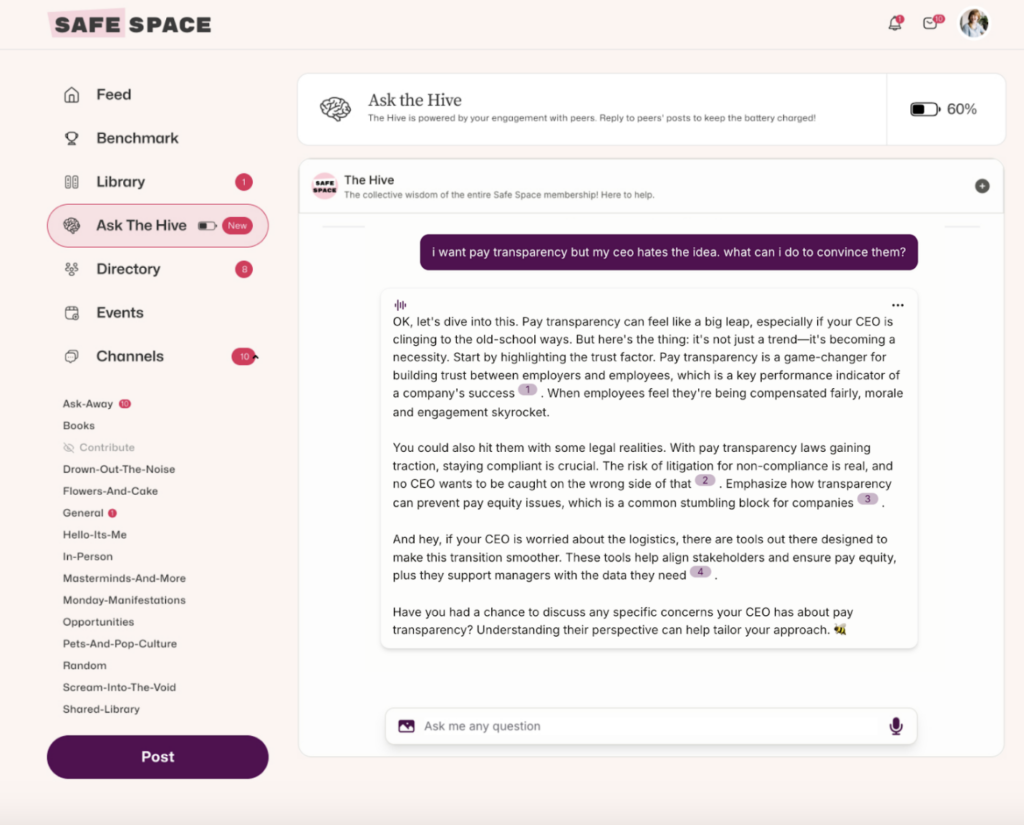🙃 negative attitudes

✍🏾 When trying to change an organization’s culture, what advice do you have for managing people that have negative attitudes and low expectations?
Context: N/A
📣 Margaret Spencer, General Manager @ Unexpected Tours and Training:
For this situation, I’d adopt the motto “slow but steady wins the race. “
When people have negative attitudes or low expectations, it can be from seeing efforts attempted in the past that get forgotten about, fail, or trickle into nothingness, so they’re skeptical about a new effort. I recommend that consistency is key, so I’d come up with a 2-3 year plan of slow but steady efforts, plus surveys, that will show that you’re moving the needle.
Negative attitudes can also be because people are just negative, but I’m choosing to look at this with positive regard!
I’d also get buy-in from leadership. Each department must commit to the culture shift for it to be fully effective. The buy-in is critical or else you’ll feel like you’re the only one working towards change.
Buy-in can mean a lot of different things – budget for events, verbal contributions, newsletter contributions, ERG efforts, a lil activity during each meeting, check-ins, mentorship, etc. To get the buy-in, you should start by getting a really clear picture about why YOU think the culture shift is necessary, the goals of the culture shift, what benchmarks you’re starting with, what tools you’ll use, etc. If you have a clear picture of all of that, it will help everyone get on board!
📣 Pooja Samuel, Senior Manager, People & Culture @ EasyLlama:
I agree with Margaret; when folks are critical of change or have low expectations for cultural initiatives, it’s usually because they’ve seen these efforts fall flat before, or they’ve experienced organizations not following through on their commitments.
My approach in these situations always starts with one-on-one conversations. I want to understand the root cause of their concerns. It could be burnout, feeling unrecognized, or experiencing a significant shift in their role, department, or sense of value within the organization. I also run stay interviews annually across the organization, which is a great opportunity to connect with employees who might be feeling this way.
Next, I focus on giving these employees an opportunity to influence the change… within reason. This might look like involving them in focus groups, having them peer-review communications, or inviting their input into the change management plan. What’s important here is closing the loop: I make sure to communicate clearly how their contributions helped shape the initiative. This actively rebuilds trust and shows that their voice has an impact.
Highlighting quick wins is another key part of my approach. This is a standard practice for us during any change management process to build momentum and show progress in real time. It helps to bring the team along as the change unfolds.
Finally, plus one to Margaret’s point about leadership alignment. It’s so important that leaders understand how to communicate the change clearly and consistently. I always equip them with talking points or FAQs to help them answer questions, drive alignment, and provide reassurance. Most importantly, I encourage them to create space for open, transparent conversations with their teams; it goes a long way in helping employees feel heard and supported throughout the change.
📣 Luke Willman, Engagement & Culture @ St. Elizabeth Physicians:
That’s a really important question – because when you’re trying to shift an organization’s culture, how you manage those negative attitudes and low expectations can make or break your momentum.
JOIN 150K+ HR LEADERS
Get insights, learnings, and advice on how to build companies and cultures that people actually love.
No spam. Unsubscribe any time.
My response assumes the skepticism is not coming from senior leaders, if your efforts are not fully aligned with their vision (actions speaking louder than words), there is little chance that changes will stick. Because leadership sets the tone for the entire organization, cultural shifts start almost exclusively at the top. Executive’s consistency, the visibility they create for engagement efforts, and their willingness to model the culture you’re trying to build is a make-or-break foundation.
From what I’ve seen in our employee engagement and improvement/action planning work, the process has to be rooted in empathy and clarity. Often, negativity stems from unmet expectations, feeling unheard, or past experiences where efforts didn’t lead to change. So before pushing for buy-in, it’s important to listen – really listen – to understand where the skepticism is coming from along with the opportunities for improvement. Sondra hits the nail on the head with empathetic listening – the perspective/TRUTH of your team members should always be valid. From there, I’ve found that the most powerful tool you have in your toolbox is creating and celebrating early wins. These don’t have to be major overhauls – they just need to be visible, meaningful, and repeatable. For example, the simple act of sharing engagement results at a high level with front-line team members builds engagement through that visibility. We’ve seen leaders start holding structured 1:1s where associates are asked thoughtful, open-ended questions about communication, recognition, and workload – and then actually follow up on what they learn. Another simple but effective win is a well-executed recognition campaign that highlights small daily contributions through peer-to-peer shoutouts or more formal recognition by leaders. Public (visual win boards) and private (personal kudos and useful feedback) reinforce values and build pride. These kinds of efforts show quick, tangible results and often help shift mindsets from “Why bother?” to “Maybe this time is different.” When people see that things are changing – and that their colleagues are getting involved and benefiting – they’re more likely to shift their outlook. It’s about building credibility through action, not just talk.
And Margaret is so right. Remind yourself regularly that changing culture doesn’t happen with a flip of a switch. It’s about consistently improving, reinforcing what’s working, and refusing to let cynicism derail progress. Even small, steady shifts can create momentum – and over time, that’s what builds trust, belonging, and lasting engagement.
Good luck! Research shows employee engagement can positively impact so much in an organization – turnover/retention, safety, quality, absenteeism, shrinkage, customer loyalty, productivity, and even profitability. The juice is worth the squeeze;)
Safe Space members can join this discussion here. Not a member yet? Apply to join here.

✍🏾 How can I support myself and colleagues if our “HR” is only one person (and they are the one giving us trouble)?
Context: Small (less than 30 people) educational non-profit. A majority of staff are in their 40s/50s and a few of us are under 30. Leadership (COO/HR person and CEO) are in their 60s/70s.
📣 Antonia Calzetti, Talent Acquisition Director:
Being in a small organization where the HR person is creating challenges can be really tough. If you’re navigating this kind of situation, here are a few things to consider:
Find your allies – Look for colleagues in more senior or influential roles who you trust and who might be seeing the same issues. Internal support can make a big difference.
Document everything – Keep clear records of problematic interactions, conversations, or policy decisions. Dates, times, and facts matter if things need to be escalated later.
Review your employee handbook – It might give you insight into policies, reporting structures, or processes you can use to address the issue.
Address as a united front – If others are seeing the same problems, consider approaching leadership as a small, united group. There’s strength in numbers, and it shows the issue isn’t isolated.
Prepare before escalating – If you’re bringing concerns to senior leadership or the CEO, go prepared:
Have a few solid, specific examples
Offer potential solutions, not just problems
Tie your concerns back to company values, culture, and impact
Start on a positive note – show that your goal is to improve the organization, not stir up conflict
Hope this is helpful!
📣 Jun Yi Tan, Head of People Operations @ 60 Decibels:
This is a really tough challenge to navigate and Antonia’s recommendations are great.
When finding your allies, I would also recommend figuring out who held the HR role prior to your current colleague. If it was someone who left the organization, this won’t be as relevant but it could be someone who acted as an interim HR before you grew large enough to hire your current HR role. They would likely have a good understanding of the HR workflows/senior leadership dynamics and the best way to raise your concerns.
📣 Tyson Simmons, Director of Human Resources @ Hardware Sales Inc.:
First of all, you and your colleagues deserve better. One thought that comes to mind is grounding your feedback in the organization’s own words. Try to align the issues you and your colleagues are experiencing to the organization’s mission, vision, values, or code of conduct. If the behavior you’re seeing from this HR leader seems out of sync with those foundational principles, there’s a strong case to be made using the organization’s own language.
Find allies and use your stories and data to gently but clearly show how the dynamic being created is affecting the organization’s turnover and/or morale. Being a non-profit, leadership should be mission-driven and should care deeply if a single person’s actions are negatively impacting the culture and the goals of the organization.
This might also be a moment for you to lead. When a designated leader falls short, it’s an opportunity for someone else to step forward. This doesn’t mean staging a mutiny or turning people against someone. It means choosing to act from your values, modeling the culture you want to see, and being the kind of leader your colleagues need right now, whether or not you have the title.
If you’re able to bring this to your CEO or board, frame it as a call-in, not a call-out. You’re not just advocating for a better workplace, you’re reminding the organization of who it says it wants to be.
Sometimes change starts when someone dares to name what others have been carrying in silence.
Safe Space members can join this discussion here. Not a member yet? Apply to join here.


